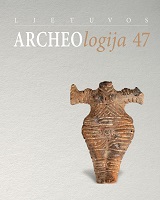ANTHROPOMORPHIC FIGURINES, GYNOCENTRISM AND GIMBUTAS’ RECEPTION INSIDE ARCHAEOLOGY AND BEYOND
ANTHROPOMORPHIC FIGURINES, GYNOCENTRISM AND GIMBUTAS’ RECEPTION INSIDE ARCHAEOLOGY AND BEYOND
Author(s): Julia MattesSubject(s): Archaeology, Gender Studies, Gender history, Politics and society, Prehistory
Published by: Lietuvos istorijos institutas
Keywords: Gimbutas; Lithuania; figurines; tattoo; body modification; ancestors; feminist movement;
Summary/Abstract: Gimbutas’ topicalisation of gynocentrism was of great significance in stimulating the study of figurines, influencing the humanities beyond archaeology, as well as a variety of international socio-political movements. The creations have a long tradition of being linked to fertility and suffer a predominantly one-sided treatment in research. In this context, the intellectual history of the interpretation of prehistoric social living conditions is analysed, critically questioned and the extent to which historically evolved role models are present in past and recent research is examined. On the basis of selected examples, the methods of ethnological analogy and stylistic analysis are used to contribute to the interpretation of the decorations of the SE European Neolithic material. Additionally, an application-related interpretation is proposed for the Cucuteni-Tripolye figurines of the Poduri set. The second part addresses the impact history of Gimbutas’ opus. Regardless of the justified methodological criticism, its various imprints on e.g. ethnography, feminist studies, as well as outside academia will be acknowledged. The contributions profoundly inspired a variety of societal currents in the USA, Germany and post-socialist Lithuania.
Journal: Lietuvos archeologija
- Issue Year: 2021
- Issue No: 47
- Page Range: 91-124
- Page Count: 34
- Language: English

